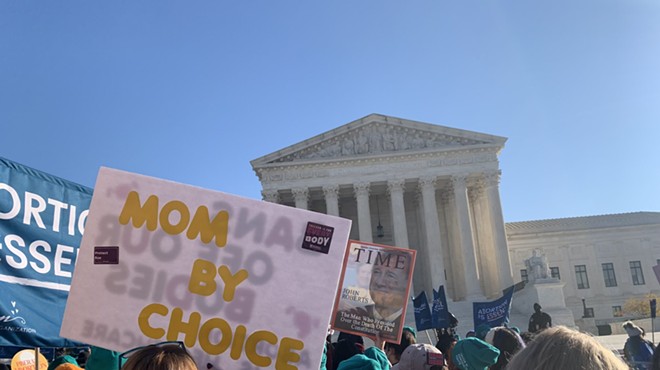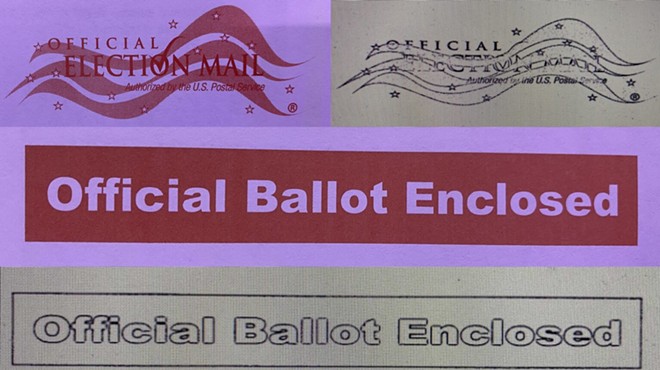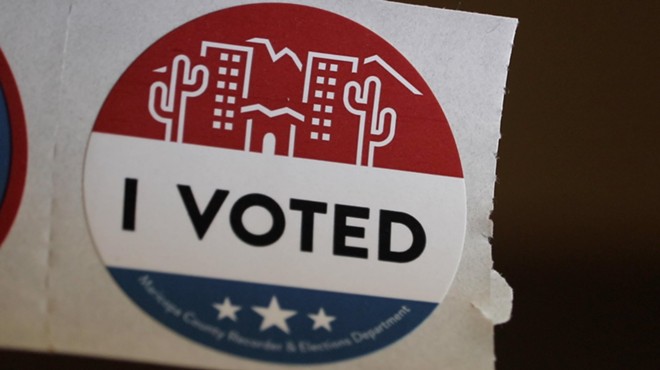Tuesday, January 17, 2017
A Dollar a Day, and Other Observations About Ducey's Education Funding Proposal
Governor Ducey surprised me by proposing $114 million in new education funds for the upcoming state budget. That's $90 million more than I expected. According to Senator Steve Farley (D-Tucson), most of that comes from highway funds. Meaning, to paraphrase It's A Wonderful Life, every time a school bell rings, a roadway gets a pothole.
More than $100 million for education isn't nothing. It's not nearly enough (It moves us from 49th in per student spending all the way to . . . 49th), but it's a significant amount of money. Unlike last year when Ducey called money covering the increase in the number of students and inflation "new money"—that was a lie—this time, it's actually new money, above and beyond the required stay-even funding. We need to remember, however, this is only a proposed budget. The legislature passes the budget, not the governor. It's going to take some gubernatorial arm twisting to get the anti-"government schools" crowd to vote for all that new money. Don't be surprised if the final education budget comes in quite a bit lower. I hope no one is taking Ducey's money to the bank yet.
Let's take a look at how Ducey wants his proposed education funding to be spent.
His proposed teacher pay hike gets the most buzz, but it's only $13.6 million, compared to almost three times as much—$38 million—for "results-based funding." The pay raise comes to about a dollar a day, which is more of an insult to teachers than a pat on the back. It's wealthy,Cold Stone Stone Cold Doug Ducey saying, "Here's a crisp new dollar bill for each of you for the great work you're doing!" I hope he doesn't expect current teachers to go out of their way to thank him, or prospective new employees to flood school districts begging for one o' them high payin' teachin' jobs. Saying "I raised teacher salaries" makes for a great campaign pitch come reelection time, but a dollar a day doesn't put food on a teacher's table.
That $38 million for "results-based funding," on the other hand, is real money for those lucky schools that get a chunk of it. It's a third of Ducey's new money, and it will go to 10 percent of Arizona's schools. That comes to an average of more than $350 per student for each of the recipients, which is more than the $325 per student schools received from the Prop 123 money. All his other proposals are small ball stuff, but this one can have some big league consequences. It's enough for the schools to increase and improve their teaching supplies and technology and still have money left for significant teacher raises, all of which will make those schools more attractive to parents and teachers. And most of it will go to districts and charter schools educating the most privileged students. The main educational beneficiaries will be the current winners in the state's income inequality wars. To the victors go the "results-based funding" spoils.
Gov. Jan Brewer proposed this idea back in 2013 together with disgraced Ed Supe John Huppenthal. They called it "performance funding." That name didn't go over very well, so in 2014, she changed the name to "student success funding." Ducey's wordsmiths concocted a third name change, the current "results-based funding." But the idea is the same. Schools with high state test scores get more money.
If "results-based funding" becomes law, schools whose AzMERIT scores are in the top 10 percent will be rewarded with more money, under the false assumption that higher scores mean higher quality education. The lion's share of that money will go to schools filled with privileged kids from families with high incomes and college educations. Those already-advantaged students perform well everywhere, regardless of whether the teaching and curriculum are first rate or mediocre. That's true in Arizona, in every other state in the nation and every country in the world. A while back, I created a map of the greater Tucson area with the state grade of every district and charter school. With a few exceptions, the high rent areas have the highest scores and the low rent areas have the lowest scores. I created a similar map in the Phoenix area with identical results. Some critics of standardized tests say, sarcastically, we should stop wasting time giving the tests and just give state grades by zip code. That jibe isn't far from the truth.
Ducey uses smoke and mirrors to hide the huge benefit his "results-based" will have for district and charter schools attended by students from the state's wealthiest families. His plan gives more money to top 10 percent schools where more than 60 percent of their students qualify for free and reduced lunch—$400 per student at the lower income schools compared to $225 per student at the others—meaning his plan is significantly more generous to schools whose high test scores beat the odds. The problem is, damn few schools with low income students beat the odds enough to make it into AzMERIT's top 10 percent.
Only one other item has a lot of money attached. Ducey plans to give $20 million to school districts and charters whose student population drops more than 2 percent below their projections. If I read this right, and I think I did, this isn't new money at all. It's compensation for a bad new law which says districts get money for the actual students they see during the current year instead of the projected enrollment from the year before. This creates a tremendous uncertainty for districts and charters. If they hire staff based on projections, they may be forced to let teachers go, possibly mid-year, if their student numbers are lower than expected, which would be tremendously disruptive. The $20 million is more a temporary correction to a punitive law than actual new money.
All the other items in Ducey's proposed budget are hardly more than token amounts of money given to worthwhile programs. They're nice, and they'll help some teachers and some schools, but statewide, they don't move the needle in any significant way.
More than $100 million for education isn't nothing. It's not nearly enough (It moves us from 49th in per student spending all the way to . . . 49th), but it's a significant amount of money. Unlike last year when Ducey called money covering the increase in the number of students and inflation "new money"—that was a lie—this time, it's actually new money, above and beyond the required stay-even funding. We need to remember, however, this is only a proposed budget. The legislature passes the budget, not the governor. It's going to take some gubernatorial arm twisting to get the anti-"government schools" crowd to vote for all that new money. Don't be surprised if the final education budget comes in quite a bit lower. I hope no one is taking Ducey's money to the bank yet.
Let's take a look at how Ducey wants his proposed education funding to be spent.
His proposed teacher pay hike gets the most buzz, but it's only $13.6 million, compared to almost three times as much—$38 million—for "results-based funding." The pay raise comes to about a dollar a day, which is more of an insult to teachers than a pat on the back. It's wealthy,
That $38 million for "results-based funding," on the other hand, is real money for those lucky schools that get a chunk of it. It's a third of Ducey's new money, and it will go to 10 percent of Arizona's schools. That comes to an average of more than $350 per student for each of the recipients, which is more than the $325 per student schools received from the Prop 123 money. All his other proposals are small ball stuff, but this one can have some big league consequences. It's enough for the schools to increase and improve their teaching supplies and technology and still have money left for significant teacher raises, all of which will make those schools more attractive to parents and teachers. And most of it will go to districts and charter schools educating the most privileged students. The main educational beneficiaries will be the current winners in the state's income inequality wars. To the victors go the "results-based funding" spoils.
Gov. Jan Brewer proposed this idea back in 2013 together with disgraced Ed Supe John Huppenthal. They called it "performance funding." That name didn't go over very well, so in 2014, she changed the name to "student success funding." Ducey's wordsmiths concocted a third name change, the current "results-based funding." But the idea is the same. Schools with high state test scores get more money.
If "results-based funding" becomes law, schools whose AzMERIT scores are in the top 10 percent will be rewarded with more money, under the false assumption that higher scores mean higher quality education. The lion's share of that money will go to schools filled with privileged kids from families with high incomes and college educations. Those already-advantaged students perform well everywhere, regardless of whether the teaching and curriculum are first rate or mediocre. That's true in Arizona, in every other state in the nation and every country in the world. A while back, I created a map of the greater Tucson area with the state grade of every district and charter school. With a few exceptions, the high rent areas have the highest scores and the low rent areas have the lowest scores. I created a similar map in the Phoenix area with identical results. Some critics of standardized tests say, sarcastically, we should stop wasting time giving the tests and just give state grades by zip code. That jibe isn't far from the truth.
Ducey uses smoke and mirrors to hide the huge benefit his "results-based" will have for district and charter schools attended by students from the state's wealthiest families. His plan gives more money to top 10 percent schools where more than 60 percent of their students qualify for free and reduced lunch—$400 per student at the lower income schools compared to $225 per student at the others—meaning his plan is significantly more generous to schools whose high test scores beat the odds. The problem is, damn few schools with low income students beat the odds enough to make it into AzMERIT's top 10 percent.
Only one other item has a lot of money attached. Ducey plans to give $20 million to school districts and charters whose student population drops more than 2 percent below their projections. If I read this right, and I think I did, this isn't new money at all. It's compensation for a bad new law which says districts get money for the actual students they see during the current year instead of the projected enrollment from the year before. This creates a tremendous uncertainty for districts and charters. If they hire staff based on projections, they may be forced to let teachers go, possibly mid-year, if their student numbers are lower than expected, which would be tremendously disruptive. The $20 million is more a temporary correction to a punitive law than actual new money.
All the other items in Ducey's proposed budget are hardly more than token amounts of money given to worthwhile programs. They're nice, and they'll help some teachers and some schools, but statewide, they don't move the needle in any significant way.
Tags: Doug Ducey , Education funding , Results-based funding , Teacher salaries , AzMERIT














